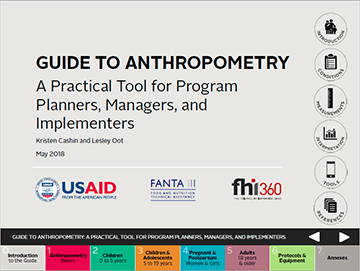 This user-friendly reference offers up-to-date information and step-by-step instructions on using anthropometry to assess the nutritional status of individuals and communities. The guide, which replaces the 2003 Anthropometric Indicators Measurement Guide, explains anthropometric measurements/indices and the nutrition conditions they assess in different demographic groups, discusses how to interpret anthropometric data, and offers guidance on selecting equipment for taking measurements in low-resource settings.
This user-friendly reference offers up-to-date information and step-by-step instructions on using anthropometry to assess the nutritional status of individuals and communities. The guide, which replaces the 2003 Anthropometric Indicators Measurement Guide, explains anthropometric measurements/indices and the nutrition conditions they assess in different demographic groups, discusses how to interpret anthropometric data, and offers guidance on selecting equipment for taking measurements in low-resource settings.
This resource can be used to better collect, understand, and use anthropometric data as part of service provision, surveillance, surveys, monitoring and evaluation, or program design. Its guidance is based on important developments in assessing nutritional status: the 2006 WHO Child Growth Standards for children from birth to 5 years, the 2007 WHO Growth Reference for children 5–19 years, and the use of mid-upper arm circumference as a key indicator for acute malnutrition. The guide also covers adolescents and adults, reflecting growing attention on the health and nutrition of those groups in developing countries.
Note: For best results, please download the PDF and open in Adobe Acrobat Reader.
Download Individual Modules [Low-Bandwidth]
- Module 1: Anthropometry Basics
- Module 2: Children from Birth to 5 Years of Age
- Module 3: Children and Adolescents 5–19 Years of Age
- Module 4: Pregnant and Postpartum Women and Girls
- Module 5: Adults (18 Years of Age and Older) (non-pregnant, non-postpartum)
- Module 6: Measurement Protocols and Equipment Guidance
- Annexes


